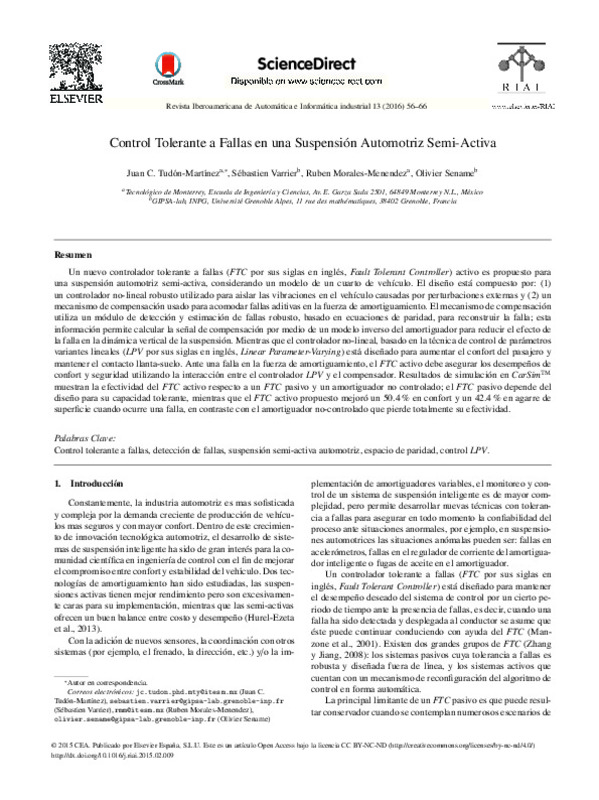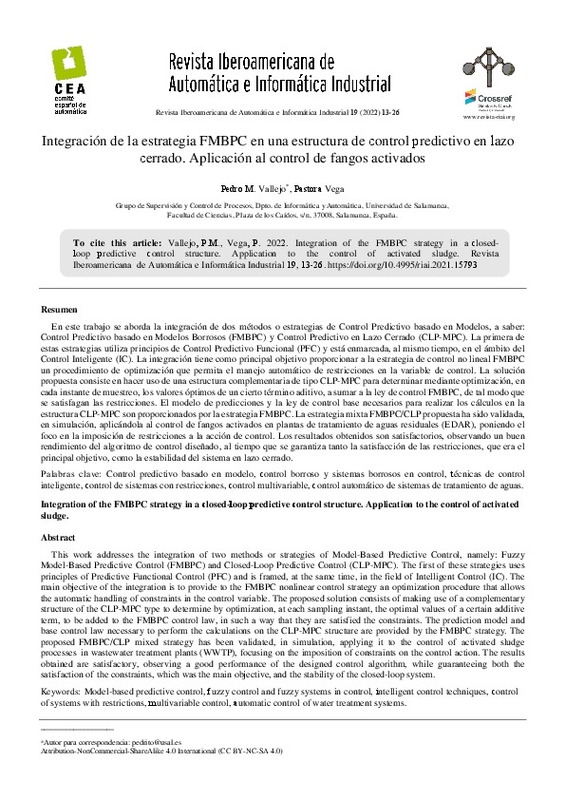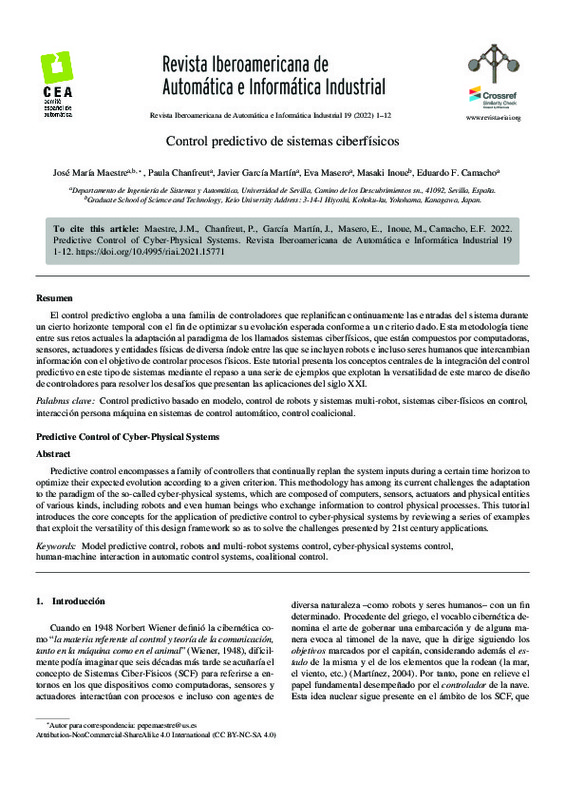JavaScript is disabled for your browser. Some features of this site may not work without it.
Buscar en RiuNet
Listar
Mi cuenta
Estadísticas
Ayuda RiuNet
Admin. UPV
Control Tolerante a Fallas en una Suspensión Automotriz Semi-Activa
Mostrar el registro sencillo del ítem
Ficheros en el ítem
| dc.contributor.author | Tudón Martínez, Juan C.
|
es_ES |
| dc.contributor.author | Varrier, Sébastien
|
es_ES |
| dc.contributor.author | Morales Menéndez, Rubén
|
es_ES |
| dc.contributor.author | Sename, Olivier
|
es_ES |
| dc.date.accessioned | 2020-05-18T13:48:20Z | |
| dc.date.available | 2020-05-18T13:48:20Z | |
| dc.date.issued | 2016-01-10 | |
| dc.identifier.issn | 1697-7912 | |
| dc.identifier.uri | http://hdl.handle.net/10251/143572 | |
| dc.description.abstract | [ES] Un nuevo controlador tolerante a fallas (FTC por sus siglas en inglés, Fault Tolerant Controller) activo es propuesto para una suspensión automotriz semi-activa, considerando un modelo de un cuarto de vehículo. El diseño está compuesto por: (1) un controlador no-lineal robusto utilizado para aislar las vibraciones en el vehículo causadas por perturbaciones externas y (2) un mecanismo de compensación usado para acomodar fallas aditivas en la fuerza de amortiguamiento. El mecanismo de compensación utiliza un módulo de detección y estimación de fallas robusto, basado en ecuaciones de paridad, para reconstruir la falla; esta información permite calcular la señal de compensación por medio de un modelo inverso del amortiguador para reducir el efecto de la falla en la dinámica vertical de la suspensión. Mientras que el controlador no-lineal, basado en la técnica de control de parámetros variantes lineales (LPV por sus siglas en inglés, Linear Parameter-Varying) está diseñado para aumentar el confort del pasajero y mantener el contacto llanta-suelo. Ante una falla en la fuerza de amortiguamiento, el FTC activo debe asegurar los desempeños de confort y seguridad utilizando la interacción entre el controlador LPV y el compensador. Resultados de simulación en CarSimTM muestran la efectividad del FTC activo respecto a un FTC pasivo y un amortiguador no controlado; el FTC pasivo depende del diseño para su capacidad tolerante, mientras que el FTC activo propuesto mejoró un 50.4% en confort y un 42.4% en agarre de superficie cuando ocurre una falla, en contraste con el amortiguador no-controlado que pierde totalmente su efectividad. | es_ES |
| dc.description.abstract | [EN] A new active Fault Tolerant Controller (FTC) is proposed for an automotive semi-active suspension, by considering a quarter of vehicle model. The design is composed by: (1) a robust non-linear controller used to isolate vibrations into the vehicle caused by external disturbances and (2) a mechanism of compensation used to accommodate additive faults in the damping force. The compensation mechanism uses a robust fault detector, based on parity space, to estimate the fault; this information allows the computation of the compensation signal by using the inverse dynamics of a damper model to reduce the fault effect into the vertical dynamics of the suspension. The non-linear controller, based on the Linear Parameter-Varying (LPV) control theory, is designed to increase the passengers comfort and ensure the wheel-road contact. When a fault occurs in the damping force, the active FTC must hold the performances of comfort and road holding by using the interaction between the LPV controller and the compensatory module. Simulation results in CarSimTM show the effectiveness of the proposed active FTC versus a passive FTC and an uncontrolled damper; the passive FTC needs to include all faults into its design for having a good fault-tolerant capability, while the proposed active FTCimproves a 50.4% in comfort and 42.4% in road holding when a fault occurs, in contrast with the uncontrolled damper that loses completely its effectiveness. | es_ES |
| dc.description.sponsorship | Este trabajo fue parcialmente apoyado por el proyecto bilateral México-Francia CONACyT PCP 03/10 y el proyecto Francés INOVE ANR 2010 BLAN 0308. | es_ES |
| dc.language | Español | es_ES |
| dc.publisher | Elsevier | es_ES |
| dc.relation.ispartof | Revista Iberoamericana de Automática e Informática industrial | es_ES |
| dc.rights | Reconocimiento - No comercial - Sin obra derivada (by-nc-nd) | es_ES |
| dc.subject | Fault tolerant control | es_ES |
| dc.subject | Fault detection | es_ES |
| dc.subject | Semi-active automotive suspension | es_ES |
| dc.subject | Parity space | es_ES |
| dc.subject | LPV control | es_ES |
| dc.subject | Control tolerante a fallas | es_ES |
| dc.subject | Detección de fallas | es_ES |
| dc.subject | Suspensión semi-activa automotriz | es_ES |
| dc.subject | Espacio de paridad | es_ES |
| dc.subject | Control LPV | es_ES |
| dc.title | Control Tolerante a Fallas en una Suspensión Automotriz Semi-Activa | es_ES |
| dc.title.alternative | Fault Tolerant Control in a Semi-Active Automotive Suspension | es_ES |
| dc.type | Artículo | es_ES |
| dc.identifier.doi | 10.1016/j.riai.2015.02.009 | |
| dc.relation.projectID | info:eu-repo/grantAgreement/CONACyT//PCP 03%2F10/ | es_ES |
| dc.relation.projectID | info:eu-repo/grantAgreement/ANR//ANR-10-BLAN-0308/FR/INtegrated approach of Observation and control and VEhicle dynamics/INOVE/ | es_ES |
| dc.rights.accessRights | Abierto | es_ES |
| dc.description.bibliographicCitation | Tudón Martínez, JC.; Varrier, S.; Morales Menéndez, R.; Sename, O. (2016). Control Tolerante a Fallas en una Suspensión Automotriz Semi-Activa. Revista Iberoamericana de Automática e Informática industrial. 13(1):56-66. https://doi.org/10.1016/j.riai.2015.02.009 | es_ES |
| dc.description.accrualMethod | OJS | es_ES |
| dc.relation.publisherversion | https://doi.org/10.1016/j.riai.2015.02.009 | es_ES |
| dc.description.upvformatpinicio | 56 | es_ES |
| dc.description.upvformatpfin | 66 | es_ES |
| dc.type.version | info:eu-repo/semantics/publishedVersion | es_ES |
| dc.description.volume | 13 | es_ES |
| dc.description.issue | 1 | es_ES |
| dc.identifier.eissn | 1697-7920 | |
| dc.relation.pasarela | OJS\9325 | es_ES |
| dc.contributor.funder | Consejo Nacional de Ciencia y Tecnología, México | es_ES |
| dc.contributor.funder | Agence Nationale de la Recherche, Francia | es_ES |
| dc.description.references | Apkarian, P., & Gahinet, P. (1995). A convex characterization of gain-scheduled H/sub ∞/ controllers. IEEE Transactions on Automatic Control, 40(5), 853-864. doi:10.1109/9.384219 | es_ES |
| dc.description.references | Börner, M., Isermann, R., Schmitt, M., 2002. A sensor and process fault detection system for vehicle suspension systems. In: SAE 2002 World Congress & Exhibition. USA, technical paper: 2002-01-0135. | es_ES |
| dc.description.references | Chamseddine, A., & Noura, H. (2008). Control and Sensor Fault Tolerance of Vehicle Active Suspension. IEEE Transactions on Control Systems Technology, 16(3), 416-433. doi:10.1109/tcst.2007.908191 | es_ES |
| dc.description.references | Chow, E., & Willsky, A. (1984). Analytical redundancy and the design of robust failure detection systems. IEEE Transactions on Automatic Control, 29(7), 603-614. doi:10.1109/tac.1984.1103593 | es_ES |
| dc.description.references | Do, A., Sename, O., Dugard, L., 2012. Ch.5 LPV modelling and control of semi-active dampers in automotive systems. Control of linear parameter varying systems with applications by Mohammadpour and Scherer, Springer. | es_ES |
| dc.description.references | Fergani, S., Sename, O., Dugard, L., 2014. A LPV/Hinf fault tolerant control of vehicle roll dynamics under semi-active damper malfunction. In: Proc. of the American Control Conf. USA, pp. 4482-4487. | es_ES |
| dc.description.references | Fischer, D., Börner, M., Schmitt, J., & Isermann, R. (2007). Fault detection for lateral and vertical vehicle dynamics. Control Engineering Practice, 15(3), 315-324. doi:10.1016/j.conengprac.2006.05.007 | es_ES |
| dc.description.references | Fischer, D., & Isermann, R. (2004). Mechatronic semi-active and active vehicle suspensions. Control Engineering Practice, 12(11), 1353-1367. doi:10.1016/j.conengprac.2003.08.003 | es_ES |
| dc.description.references | Gáspár, P., Szabó, Z., & Bokor, J. (2012). LPV design of fault-tolerant control for road vehicles. International Journal of Applied Mathematics and Computer Science, 22(1), 173-182. doi:10.2478/v10006-012-0013-x | es_ES |
| dc.description.references | Guo, S., Yang, S., & Pan, C. (2006). Dynamic Modeling of Magnetorheological Damper Behaviors. Journal of Intelligent Material Systems and Structures, 17(1), 3-14. doi:10.1177/1045389x06055860 | es_ES |
| dc.description.references | Ezeta, J. H., Mandow, A., & Cerezo, A. G. (2013). Los Sistemas de Suspensión Activa y Semiactiva: Una Revisión. Revista Iberoamericana de Automática e Informática Industrial RIAI, 10(2), 121-132. doi:10.1016/j.riai.2013.03.002 | es_ES |
| dc.description.references | Kim, H., & Lee, H. (2011). Fault-Tolerant Control Algorithm for a Four-Corner Closed-Loop Air Suspension System. IEEE Transactions on Industrial Electronics, 58(10), 4866-4879. doi:10.1109/tie.2011.2123852 | es_ES |
| dc.description.references | Kim, J., & Lee, H. (2011). Sensor fault detection and isolation algorithm for a continuous damping control system. Proceedings of the Institution of Mechanical Engineers, Part D: Journal of Automobile Engineering, 225(10), 1347-1364. doi:10.1177/0954407011404493 | es_ES |
| dc.description.references | de-J Lozoya-Santos, J., Morales-Menendez, R., Ramirez-Mendoza, R., Tudón-Martinez, J. C., Sename, O., & Dugard, L. (2012). Magnetorheological damper—an experimental study. Journal of Intelligent Material Systems and Structures, 23(11), 1213-1232. doi:10.1177/1045389x12445035 | es_ES |
| dc.description.references | Manzone, A., Pincetti, A., Costantini, D., 2001. Fault tolerant automotive systems: An overview. In: Proc. of the 7th Inter. On-Line Testing Workshop. Italy, pp. 117-121. | es_ES |
| dc.description.references | Poussot-Vassal, C., Sename, O., Dugard, L., Gáspár, P., Szabó, Z., & Bokor, J. (2008). A new semi-active suspension control strategy through LPV technique. Control Engineering Practice, 16(12), 1519-1534. doi:10.1016/j.conengprac.2008.05.002 | es_ES |
| dc.description.references | Poussot-Vassal, C., Spelta, C., Sename, O., Savaresi, S. M., & Dugard, L. (2012). Survey and performance evaluation on some automotive semi-active suspension control methods: A comparative study on a single-corner model. Annual Reviews in Control, 36(1), 148-160. doi:10.1016/j.arcontrol.2012.03.011 | es_ES |
| dc.description.references | Qiu, J., Ren, M., Guo, Y., & Zhao, Y. (2011). Active fault-tolerant control for vehicle active suspension systems in finite-frequency domain. IET Control Theory & Applications, 5(13), 1544-1550. doi:10.1049/iet-cta.2010.0519 | es_ES |
| dc.description.references | Scherer, C., Gahinet, P., & Chilali, M. (1997). Multiobjective output-feedback control via LMI optimization. IEEE Transactions on Automatic Control, 42(7), 896-911. doi:10.1109/9.599969 | es_ES |
| dc.description.references | Tudón-Martínez, J., Varrier, S., Morales-Menendez, R., Ramírez-Mendoza, R., Koenig, D., Martínez, J.-J., Sename, O., 2013a. Fault tolerant control with additive compensation for faults in an automotive damper. In: Proc. of the 10th IEEE Int. Conf. on Networking, Sensing and Control. France, pp. 810–814. | es_ES |
| dc.description.references | Tudón-Martínez, J., Varrier, S., Sename, O., Morales-Menendez, R., Martínez, J., Dugard, L., 2013b. Fault tolerant strategy for semi-active suspensions with LPV accommodation. In: Proc. of 2nd Int. Conf. on Control and Fault Tolerant Systems. France, pp. 631-636. | es_ES |
| dc.description.references | Varrier, S., Koenig, D., Martínez, J.-J., 2012. Robust fault detection for vehicle lateral dynamics. In: Proc. of the 51st IEEE Conf. on Decision and Control. USA, pp. 4366-4371. | es_ES |
| dc.description.references | Zhang, Y., & Jiang, J. (2008). Bibliographical review on reconfigurable fault-tolerant control systems. Annual Reviews in Control, 32(2), 229-252. doi:10.1016/j.arcontrol.2008.03.008 | es_ES |











